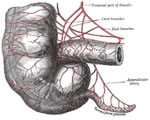 The
appendix, the worm-shaped tube attached to the colon, has long been thought
of as useless (joke is that the function of the appendix is to get appendicitis,
which ensures the continual employment of surgeons).
The
appendix, the worm-shaped tube attached to the colon, has long been thought
of as useless (joke is that the function of the appendix is to get appendicitis,
which ensures the continual employment of surgeons).Recently, it has been suggested that the appendix actually has a real function: to reboot the digestive system after a bout of gastrointestinal diseases. Now, another study has added weight to the usefulness of the appendix. In fact, it is so usefull that it evolved some 32 times throughout history:
... careful anatomical study of other mammals has revealed that species as diverse as beavers, koalas, and porcupines also have a structure jutting off of their guts in exactly the same place as our appendix—in other words, the feature is much more common among mammals than once thought.More
Now, an international team of researchers that includes Heather F. Smith, an evolutionary biologist at Midwestern University in Glendale, Arizona, and William Parker, a surgeon who studies the immune system at Duke University Medical Center in Durham, North Carolina, says it has the strongest evidence yet that the appendix serves a purpose. In a new study, published online this month in Comptes Rendus Palevol, the researchers compiled information on the diets of 361 living mammals, including 50 species now considered to have an appendix, and plotted the data on a mammalian evolutionary tree. They found that the 50 species are scattered so widely across the tree that the structure must have evolved independently at least 32 times, and perhaps as many as 38 times.

No comments:
Post a Comment